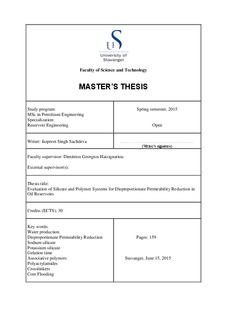| dc.description.abstract | The main objective of this work is to screen and evaluate various commercially existing polymers and silicate systems mixed with crosslinkers and/or activators for their gel-forming capabilities for the water management purposes in high water cut producing wells in the matured fields. A thorough evaluation has been done for these chemicals to evaluate their behaviour before, during and after gelation. The properties measured and monitored include gelant system's viscosity and pH, gelation time and kinetics of the gelation process, gel stability, gel strength from Maximum Compressional Pressure (MCP) tests, gel shrinkage and post-gelation time behaviour.
Traditional tube testing, also known as bottle testing, was done for the different polymer systems mixed with various crosslinkers wherein the mixtures were prepared and kept in the oven at temperatures of 40°C, 60°C and 80°C. Associative polymers were found to be very effective in forming gels with zirconium (III) crosslinker at high temperatures.
For the rheology measurements, dynamic oscillatory tests were performed for the different silicate systems mixed with activators to determine the onset of gelation (sol-gel transition point or gel point) and the viscosity increase as a function of time at different temperatures. Gel point plays an important role in the designing of successful water-shutoff treatments since it is needed to determine the time required for the injected gelant system to gel so that the time gap is sufficient for the successful placement of the prepared system. The effects of the different factors, such as silicate and activator concentrations, temperature, the concentration of divalent ions (Ca2+) etc., are investigated. The sodium silicate system was found to gel faster at lower temperatures compared to the potassium silicate system while at high temperatures the potassium silicate system gels faster than the sodium silicate system. Therefore, an appropriate silicate system can be chosen for conformance-improvement treatment depending on the important parameters like gelation time required, time required to inject and place the gelant system at the designated areas, available activator systems, depth of the reservoir, reservoir temperatures and maximum injection rates that can be achieved without damaging the reservoir among other factors.
In addition to bulk measurements and dynamic oscillatory tests, one core flood experiment was performed with associative polymer on the water-wet Berea sandstone core to investigate the effect of Disproportionate Permeability Reduction (DPR). The Berea core has shown a significant drop in the effective permeability to water and potential DPR effects after polymer injection. | nb_NO |
